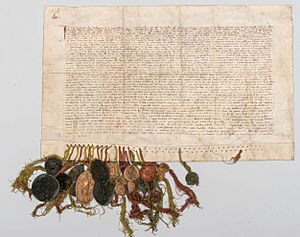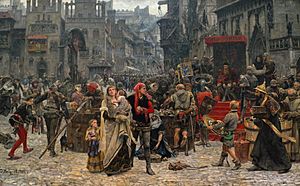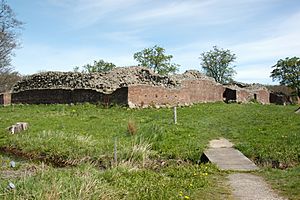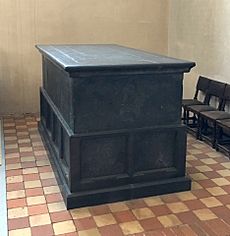Valdemar IV of Denmark facts for kids
Quick facts for kids Valdemar IV |
|||||
|---|---|---|---|---|---|
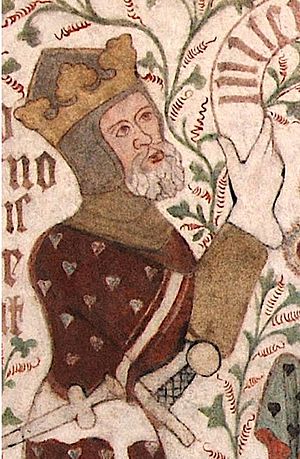
Valdemar shown on a contemporary fresco in St. Peter's Church, Næstved (Sankt Peders Kirke).
|
|||||
| King of Denmark | |||||
| Reign | 24 June 1340 – 24 October 1375 | ||||
| Predecessor | Christopher II | ||||
| Successor | Olaf II | ||||
| Born | 1320 Tikøb, Helsingør, Denmark |
||||
| Died | 24 October 1375 (aged 54–55) Gurre Castle, North Zealand, Denmark |
||||
| Burial | first at Vordingborg Castle, then Sorø Abbey | ||||
| Consort | Helvig of Schleswig | ||||
| Issue among others... |
Christopher, Duke of Lolland Ingeborg, Duchess of Mecklenburg Margaret I, Queen of Denmark |
||||
|
|||||
| House | House of Estridsen | ||||
| Father | Christopher II, King of Denmark | ||||
| Mother | Euphemia of Pomerania | ||||
| Religion | Roman Catholicism | ||||
Valdemar IV Atterdag (born 1320, died October 24, 1375) was the King of Denmark from 1340 to 1375. His nickname "Atterdag" means "Return of the Day." This name shows that he brought new hope to Denmark. He is famous for bringing Denmark back together. Before him, the country was in debt and parts of it were sold off.
Contents
Becoming King of Denmark
Valdemar was the youngest son of King Christopher II of Denmark. He spent his early life away from Denmark. He lived in Bavaria because his father had lost battles. His older brothers had also died or were imprisoned.
In 1340, a man named Niels Ebbesen killed a powerful German count. After this, Valdemar was made king in Viborg. He was only 20 years old. He married Helvig of Schleswig. Her family gave him control of about a quarter of Jutland.
Many people thought Valdemar would be easy to control. But he was smart and determined. He knew he had to get control of all Danish lands. Niels Ebbesen tried to free central Jutland from German rule. But he and his brothers were killed in battle. This event helped end German control in Denmark.
Buying Back Denmark's Lands
When Valdemar's father was king, Denmark became very poor. Parts of the country were sold off to other rulers. King Valdemar IV wanted to pay back these debts. He wanted to get all the Danish lands back.
His wife Helvig's dowry helped him pay off some debts. He also collected taxes from farmers to buy back more land in Jutland. In 1344, he got back North Friesland. He taxed this area to pay for southern Jutland. The farmers were unhappy with all the taxes.
Valdemar then focused on Zealand. The bishop of Roskilde gave Valdemar control of Copenhagen Castle. This gave Valdemar a strong base. He could collect taxes on trade through the Øresund strait. He was the first Danish king to rule from Copenhagen.
He bought or captured other castles and forts. He forced the German rulers out. When he ran out of money, he took Kalundborg and Søborg Castles by force. He also sold Danish Estonia to the Teutonic Knights. This far-off land was not very important to him. Selling it gave him money to pay off more debts in Denmark.
Around 1346, Valdemar went on a journey to Jerusalem. He became a Knight of the Holy Sepulchre. When he returned, he gathered an army. He took back Vordingborg Castle. By the end of 1346, he controlled all of Zealand. He made Vordingborg his home. He built the Goose Tower there, which is now a symbol of the town.
Valdemar was known for being tough on those who opposed him. His tax policies made farmers afraid not to pay. By 1347, Valdemar had pushed out the Germans. Denmark was once again a united country. With more money, Valdemar built a bigger army. He took Nyborg Castle and eastern Funen Island. He then turned his attention to Skåne, which was controlled by Sweden.
The Black Death Arrives
In 1349, a terrible disease called the Black Death came to Denmark. People say it arrived on a "ghost ship" in Jutland. People who went on the ship took valuable things. They also brought fleas that carried the disease.
Thousands of people started to die. For the next two years, the plague spread fast. Many towns lost most of their people. Some towns became completely empty. It is believed that between 33% and 66% of Denmark's people died. City dwellers were often hit harder than farmers.
Valdemar himself did not get sick. He used the deaths of his enemies to gain more land. He refused to lower taxes, even though fewer farmers worked less land. Nobles also saw their money shrink. This made the tax burden heavier for everyone. Uprisings happened in the years that followed.
Uniting the Last Pieces of Denmark
In 1350, Valdemar IV made an alliance with Poland. This was against the Teutonic Knights.
In 1354, the King and nobles met at the Danish Court. They tried to make peace. They agreed that the Danehof should meet once a year. The old system of rights was brought back. This system limited the king's power.
But Valdemar ignored these terms. He raised an army. He marched through southern Jutland. He took more lands that Germans had taken from Denmark. He also took the rest of Funen Island. Rebellions continued because the king did not follow the agreement.
In 1358, Valdemar met with some Jutland leaders. He refused their terms. These leaders were killed on their way home. Valdemar was blamed. The people of Jutland rebelled again.
Valdemar then focused on Skåne, which was still Swedish. In 1355, a Swedish prince rebelled against his father, King Magnus IV of Sweden. This prince took Skåne. King Magnus asked Valdemar for help. The prince died in 1359. Valdemar crossed the Sound with his army. He forced Magnus to give up Helsingborg in 1360. With Helsingborg, Valdemar got Skåne back. He also captured Halland and Blekinge.
Foreign Policy After 1360
Valdemar could not stop the growing power of the Hanseatic League. This was a group of powerful trading cities. In 1361, Valdemar decided to attack the Swedish island of Gotland. He attacked the town of Visby. He defeated the Gotlanders outside the city. He killed 1800 men. The city surrendered.
Valdemar demanded a large amount of silver and gold from Visby. The city paid him quickly. Churches were stripped of their valuables. The riches were loaded onto Danish ships. They were taken to Vordingborg. Valdemar added "King of Gotland" to his titles. But his actions against Visby, a Hanseatic city, would cause problems later.
Valdemar tried to influence who would become the next king of Sweden. He captured a princess who was supposed to marry the Swedish Crown Prince. He convinced King Magnus of Sweden that his son should marry Valdemar's daughter, Margrethe. The king agreed, but the Swedish nobles did not. They forced Magnus to step down.
The nobles chose Albrecht of Mecklenburg as King of Sweden. Albrecht was an enemy of Valdemar. He convinced the Hanseatic cities to work with him. Valdemar was threatening their trade routes and the valuable herring fishing.
Valdemar attacked the Hanseatic fleet. The Hanseatic cities demanded action. In 1362, the Hanseatic states, Sweden, and Norway formed an alliance against Valdemar. They sent a fleet and an army. They attacked and looted Copenhagen and parts of Skåne. Along with rebellious nobles in Jutland, they forced Valdemar out of Denmark in 1368.
Valdemar appointed his friend Henning Podebusk to negotiate. They agreed to a truce. Valdemar had to allow free trade and fishing rights in the Sound. The Hanseatic League took control of some towns in Skåne and Helsingborg for 15 years. They also gained a say in who would become king after Valdemar.
Valdemar had to sign the Treaty of Stralsund in 1370. This treaty recognized the Hanseatic League's rights. Valdemar was able to return to Denmark after four years. He kept Gotland, so he still gained something.
Death and Legacy
Valdemar continued to deal with rebellious nobles. He also fought the Swedes and Norwegians. He was slowly taking control of southern Jutland when he became ill.
Valdemar died at Gurre Castle in north Zealand on October 24, 1375. He was buried at Sorø Abbey.
King Valdemar was a very important figure in Danish history. He slowly got back the lands that Denmark had lost. He used strong methods and collected many taxes. This led to many uprisings during his rule. He wanted to make Denmark a powerful country again. Danes welcomed this at first. But his policies faced strong opposition from the noble families.
He made the king's power stronger. This was based on his military strength and loyal nobles. Many foreigners became court officials. The most important was Henning Podebusk, who was like a prime minister.
Valdemar IV is seen as one of Denmark's most important medieval kings. He was intelligent, clever, and good at politics and money. His grandson, Olaf II, became his successor. Olaf was the son of Valdemar's daughter, Margaret.
Many stories, songs, and poems have been written about Valdemar. He became a Danish hero king in the mid-1800s. This was when Denmark was fighting Germany for its southern lands.
Issue
In the 1330s, Valdemar married Helvig of Schleswig. She brought a part of Jutland as her dowry. The wedding took place at Sønderborg Castle in 1340. After the wedding, they went to Viborg. There, they were officially welcomed as king and queen.
With his wife Helvig, Valdemar IV had the following children:
- Christopher of Denmark, Duke of Lolland (1341–1363)
- Margaret of Denmark (1345–1350), who died young.
- Ingeborg of Denmark (1347–1370). She married Henry III, Duke of Mecklenburg. She was the grandmother of King Eric VII of Denmark.
- Catherine of Denmark (1349), who died young.
- Valdemar of Denmark (1350 – 11 June 1363), who died young.
- Margaret I of Denmark (1353–1412). She married King Haakon VI of Norway. She became Queen of Denmark, Norway, and Sweden.
Distinctions
- Knight of the Holy Sepulchre
Other sources
- Fletcher Pratt (1950) The Third King, a biography of Valdemar Atterdag, Sloane. ISBN: 978-1299313118
- Peter Lundbye (1939) Valdemar Atterdag: Danmarks Riges Genopretter, skildret i ny historisk Belysning efter de samtidige Kilders Beretning, Copenhagen: Ejnar Munksgaard.
See also
 In Spanish: Valdemar IV de Dinamarca para niños
In Spanish: Valdemar IV de Dinamarca para niños


